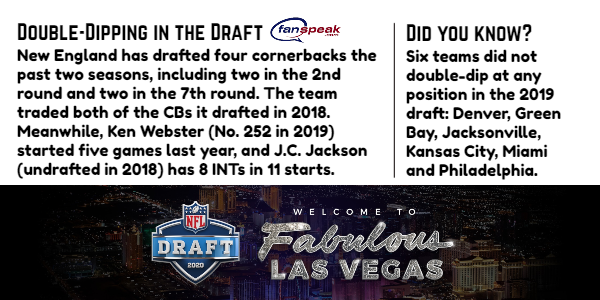Mock Draft Tips: Should your team ‘double-dip’ at a position of need?

As part of an occasional series, Fanspeak will offer tips and best practices for its wildly popular and first-of-its-kind On The Clock draft simulator.
Today’s topic: Thinking about drafting multiple players at the same position? Be careful what you wish for.
Baltimore may still look for a true No. 1 wide receiver, but the other two starting receiver spots are taken care of for the foreseeable future.
At the very least, Carolina now has depth, if not at least one starter, at the all-important offensive tackle position.
Las Vegas took a pass rusher with a top-5 pick, but it was their fourth-round pick at the same position who had the better season.
“Double-dipping,” or selecting more than one player at the same position, is not only a favorite strategy of those who use Fanspeak’s On The Clock NFL draft simulator, it’s apparently a favorite strategy of general managers, too, as 80 percent of the league went back for seconds at a position last year.
So how did it work out for those teams?
The results are a mixed bag.
Rumor Mill: #Broncos Planning on Double-Dipping for Speed in Top-100 of #NFLDrafthttps://t.co/a1XYhIXV7k pic.twitter.com/4vGdMf3QLC
— Denver Broncos On SI.com (@BroncosOnScout) February 4, 2020
Who went back for seconds?
Out of the 26 teams that double-dipped at a position, 11 drafted rookies at the same position who started at least one game.
In other words, double-dipping didn’t produce multiple rookie starters for most teams.
And out of those 11 teams, most of the double-dipped rookies only started one game, like Arizona receiver Andy Isabella, Buffalo tight end Tommy Sweeney and Cleveland’s Sione Takitaki.
However, the draft strategy was a boon for teams like Baltimore, the New York Giants and Las Vegas. Overall, six teams double-dipped at a position and received at least three starts out of those rookies: Baltimore, Carolina, the Giants, Las Vegas, Tampa and Washington.
- Baltimore: Receivers Marquise Brown was drafted in the first round and Miles Boykin in the third round. Each started 11 games, combining for 782 yards and 10 touchdowns.
- Carolina: The jury is still out on second-round pick Greg Little after the OT missed most of the season after suffering multiple concussions, but he still managed to start three games. Sixth-round pick Dennis Daley, meanwhile, started nine games, although he stumbled somewhat toward the end of the season, finishing with an overall player grade of 58.3, according to PFF (via the team’s website).
- N.Y. Giants: New York double-dipped at two positions, defensive tackle and cornerback, and had the most success with the latter. First-round pick Deandre Baker (15 starts) and fourth-round pick Julian Love (five starts) got the majority of the playing time, but sixth-round pick Corey Ballentine also started two games at cornerback. Baker (87.5 percent of team’s defensive snaps), Love (36.3) and Ballentine (26.7) combined for 1,709 snaps as rookies, according to FootballOutsiders.com.
- Las Vegas: The team made the unusual move of drafting a pass rusher in the top-5 and another one in the fourth round. To put it lightly, the move worked out. Clelin Fererell, the No. 4 overall pick, started 15 games and racked up 4.5 sacks and 8 tackles for loss. Maxx Crosby, on the other hand, had 10 sacks and 16 tackles for loss after being drafted in the fourth round. The Raiders also double-dipped at cornerback, but only one of them started.
- Tampa: Sean Murphy-Bunting had a solid season at cornerback, as the second-round pick started 10 games and picked off three passes (including one that was returned for a touchdown) in 10 starts. Jamel Dean, a third-round pick, had two interceptions in five starts.
- Washington: Everyone remembers Terry McLaurin’s rookie season, as the third-round receiver caught 58 passes for 919 yards and 7 TDs in 14 starts. But don’t forget about sixth-round pick Kelvin Harmon, who started eight games and caught 30 passes for 365 yards.
Houston, LA Rams bolster OL
Both Houston and the Los Angeles Rams also double-dipped, with the Texans drafting two OTs and two CBs and the Rams drafting two safeties and two OTs.
Both teams found success with this strategy along the offensive line.
However, in both cases, one of those tackles was moved to guard – and with great success. First-round pick Tytus Howard started eight games at OT for Houston while second-rounder Max Scharping was moved to guard and started 14 games.
For the Rams, third-round pick Bobby Evans started seven games at OT, while fifth-round pick David Edwards was moved to guard and started 10 games.
A popular, but questionable, strategy?
If your team is sorely lacking at a position, double-dipping in the draft is certainly a popular strategy, as 80 percent of the league did so last year.
But it won’t necessarily produce multiple rookie starters at the respective position, especially if the players are late-round picks.
Does your team desperately need a pass rusher, tackle or cornerback? Just remember, less than 20 percent of the teams drafted multiple players at the same position who went on to start three or more games last year.
Jake Rigdon (jake@sydwriting.com) covers the NFL draft for Fanspeak and the On The Clock, which is the only NFL draft simulator that allows you to customize and use your own big board while giving you control over trades.

